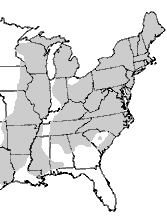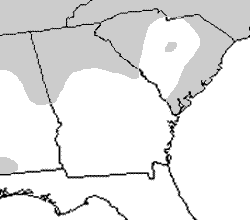Pickerel Frog (Rana [Lithobates] palustris)
Pickerel Frog (Lithobates palustris)
![ranpal210 Pickerel Frog (Rana [Lithobates] palustris)](https://srelherp.uga.edu/wp-content/uploads/sites/70/2024/01/ranpal210.jpg)


Pickerel Frog Call
Description: A medium to large frog (4.5–7.5 cm; 2–4 in) recognized by two distinct rows of dark, squarish spots running down the back between the dorsolateral folds. Background color is usually brown to greenish-brown, and the venter is pale with blotchy mottling. The concealed surfaces of the hind legs display bright yellow or orange flash coloration, which may startle predators during escape. Often confused with Leopard Frogs (L. sphenocephalus), but square dorsal spots and flash colors are reliable distinguishing features. Males are smaller than females and can be identified by paired vocal sacs, stout forearms, and swollen thumbs during the breeding season. This species produces toxic skin secretions that deter predators and can be irritating to humans.
Range and Habitat: It occurs from the Canadian Maritimes south to the Carolinas and west from Minnesota to Texas. In Georgia, it is primarily found in the Piedmont and Mountain regions. It prefers cool, slow-moving streams, ponds, lakes, and swampy areas with dense vegetation. It generally favors cooler and shadier habitats than Leopard Frogs.
Habits: Breeding occurs from late March to early May. Females deposit spherical egg masses containing 700–3,000 eggs, typically attached to submerged vegetation. Eggs hatch within days, and tadpoles require ~87–95 days to complete metamorphosis. Sexual maturity is reached after ~2 years. Tadpoles are herbivorous, while adults feed primarily on invertebrates. Pickerel Frogs are generally secretive outside of breeding, but may be seen foraging near water.
Call: A low, nasal snore-like call.
Conservation Status: Populations are stable across most of their range. They are not protected at the state or federal levels in Georgia, though habitat degradation and water quality decline may pose local threats.
